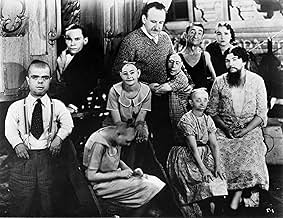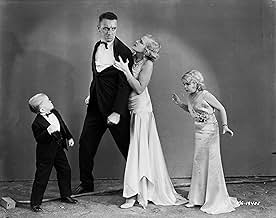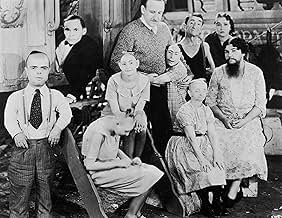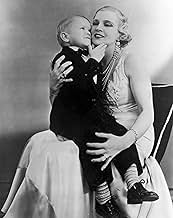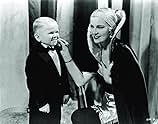CALIFICACIÓN DE IMDb
7.8/10
53 k
TU CALIFICACIÓN
Una bella trapecista acepta casarse con el cabecilla de los artistas secundarios, pero sus deformes amigos descubren que solo se quiere casar con él por su herencia.Una bella trapecista acepta casarse con el cabecilla de los artistas secundarios, pero sus deformes amigos descubren que solo se quiere casar con él por su herencia.Una bella trapecista acepta casarse con el cabecilla de los artistas secundarios, pero sus deformes amigos descubren que solo se quiere casar con él por su herencia.
- Dirección
- Guionistas
- Elenco
- Premios
- 2 premios ganados y 1 nominación en total
Roscoe Ates
- Roscoe
- (as Rosco Ates)
Prince Randian
- The Living Torso
- (as Rardion)
Opiniones destacadas
In the first place, this movie was originally made to compete with the Universal Horror films, as though these human beings who are the titular "freaks" are not human. Director Tod Browning was still reeling from the loss of his big star, Lon Chaney, to cancer, and thought this would be a good follow up to his previous horror films without Chaney. And after all, he had just finished directing Dracula.
Actually, it paints a very sympathetic picture of the disabled and deformed circus performers, who, at this time of limited medical knowledge and abounding prejudice, were very limited in what they could do in life. They have a very deep camaraderie that is shown through such events as the birth of a child to the bearded lady and the engagement of one of the conjoined twins. Since the other twin is already married, there is much arguing over what the logistics are going to be in these two marriages.
The actual "monsters" in this film are the acrobat "Cleopatra" (Olga Baclanova), and strong man Hercules (Henry Victor), who are having an affair. Two physical specimens with monstrous morality. When the dwarf Hans is captivated by Cleopatra's beauty, she at first teases him by leading him on. But then he starts giving her expensive jewelry and she decides to keep up the ruse. When Freida, Hans' dwarf girlfriend, comes to Cleopatra and asks her to stop teasing him, she accidentally tips off Cleo to the fact that Hans has inherited a great fortune. Hercules and Cleo then plan to get Hans to marry Cleo and then poison him so she can inherit his money. But the two don't realize the close strong bond that the circus performers have with one another and that they are literally each others eyes and ears. Complications ensue.
The film was originally set to run at 90 minutes, but test audiences were so revolted that 30 minutes were cut out so that the remaining film only runs at an hour. Then a scene was tacked on at the end to show Hans' grief over what has ultimately happened. MGM would often add an end scene that really didn't fit the mood of the rest the film during Irving Thalberg's reign there to wrap things up.
This film pretty much finished the career of director Browning as afterwards he only directed a farcical sound remake of a silent film he had made at MGM and one other film and then retired. This was a good late role for Olga Baclanova. She had a very thick Russian accent and had some great late silent roles at Paramount, but talking film had not been kind to her career. This really gave her one last great role where her accent really fit into the plot, plus this was not a film where lots of dialogue was called for, and she was very good at using gestures and expressions to convey emotion.
In the 1960s this film got a fresh look, and today is widely celebrated as having been ahead of its time. The horror is implied and left up to your imagination as to just HOW it happened, and the empathy shown the circus performers is profound. It even got a separate DVD release with commentary.
Actually, it paints a very sympathetic picture of the disabled and deformed circus performers, who, at this time of limited medical knowledge and abounding prejudice, were very limited in what they could do in life. They have a very deep camaraderie that is shown through such events as the birth of a child to the bearded lady and the engagement of one of the conjoined twins. Since the other twin is already married, there is much arguing over what the logistics are going to be in these two marriages.
The actual "monsters" in this film are the acrobat "Cleopatra" (Olga Baclanova), and strong man Hercules (Henry Victor), who are having an affair. Two physical specimens with monstrous morality. When the dwarf Hans is captivated by Cleopatra's beauty, she at first teases him by leading him on. But then he starts giving her expensive jewelry and she decides to keep up the ruse. When Freida, Hans' dwarf girlfriend, comes to Cleopatra and asks her to stop teasing him, she accidentally tips off Cleo to the fact that Hans has inherited a great fortune. Hercules and Cleo then plan to get Hans to marry Cleo and then poison him so she can inherit his money. But the two don't realize the close strong bond that the circus performers have with one another and that they are literally each others eyes and ears. Complications ensue.
The film was originally set to run at 90 minutes, but test audiences were so revolted that 30 minutes were cut out so that the remaining film only runs at an hour. Then a scene was tacked on at the end to show Hans' grief over what has ultimately happened. MGM would often add an end scene that really didn't fit the mood of the rest the film during Irving Thalberg's reign there to wrap things up.
This film pretty much finished the career of director Browning as afterwards he only directed a farcical sound remake of a silent film he had made at MGM and one other film and then retired. This was a good late role for Olga Baclanova. She had a very thick Russian accent and had some great late silent roles at Paramount, but talking film had not been kind to her career. This really gave her one last great role where her accent really fit into the plot, plus this was not a film where lots of dialogue was called for, and she was very good at using gestures and expressions to convey emotion.
In the 1960s this film got a fresh look, and today is widely celebrated as having been ahead of its time. The horror is implied and left up to your imagination as to just HOW it happened, and the empathy shown the circus performers is profound. It even got a separate DVD release with commentary.
A forest glade somewhere in Europe. A warm, sunny day with children playing on the grass. But the camera moves closer and reveals that something is terribly wrong. For these are not children, but tragically misshapen human beings. Pinheads. Dwarfs. A young man with only half a body. A man without arms or legs. These are the Freaks.
In 1932, director Tod Browning, fresh from his success with DRACULA, was instructed by Irving Thalberg to top FRANKENSTEIN. He succeeded. The resulting film was considered so ghastly that it was banned in Britain for 30 years. It is the strangest film MGM ever released.
Browning wanted to tell a tale of love, greed & revenge set in a circus, most particularly in the sideshow of human anomalies. He scoured Europe & America for the perfect cast. He got them: Violet & Daisy Hilton, the celebrated Siamese twins; dwarf brother & sister Harry & Daisy Earles; Johnny Eck the Half Boy (a good actor, he will remain in your mind a long time); the tragic Josephine Joseph, a hermaphrodite; as well as a human skeleton, armless girls and the female pinheads, among others.
While the plot is exploitive & the title tasteless, these people show us glimpses of their hearts, some of the agony of their condition and make us wonder, `What if I'd been born as one of them?'
The rest of the cast is made up of MGM stock players Leila Hyams, Wallace Ford, Edward Brophy, Olga Baclanova and the screen's champion stutterer Roscoe Ates.
The plot is simple. A beautiful trapeze artist marries a dwarf for his money, then plots his murder with her lover, the circus strong man. The subsequent action is both horrifying & strangely satisfying. Various scenes - the Freaks' Banquet, the chase through the storm - are among the most bizarre ever filmed. You won't soon forget the time you spend with the FREAKS.
In 1932, director Tod Browning, fresh from his success with DRACULA, was instructed by Irving Thalberg to top FRANKENSTEIN. He succeeded. The resulting film was considered so ghastly that it was banned in Britain for 30 years. It is the strangest film MGM ever released.
Browning wanted to tell a tale of love, greed & revenge set in a circus, most particularly in the sideshow of human anomalies. He scoured Europe & America for the perfect cast. He got them: Violet & Daisy Hilton, the celebrated Siamese twins; dwarf brother & sister Harry & Daisy Earles; Johnny Eck the Half Boy (a good actor, he will remain in your mind a long time); the tragic Josephine Joseph, a hermaphrodite; as well as a human skeleton, armless girls and the female pinheads, among others.
While the plot is exploitive & the title tasteless, these people show us glimpses of their hearts, some of the agony of their condition and make us wonder, `What if I'd been born as one of them?'
The rest of the cast is made up of MGM stock players Leila Hyams, Wallace Ford, Edward Brophy, Olga Baclanova and the screen's champion stutterer Roscoe Ates.
The plot is simple. A beautiful trapeze artist marries a dwarf for his money, then plots his murder with her lover, the circus strong man. The subsequent action is both horrifying & strangely satisfying. Various scenes - the Freaks' Banquet, the chase through the storm - are among the most bizarre ever filmed. You won't soon forget the time you spend with the FREAKS.
Part fictional portrait of a group of circus sideshow performers and part tragic soap opera about their various and complicated relationships, the main story has a midget, Hans (Harry Earles), falling in love with the Amazonian trapeze artist, Cleopatra (Olga Baclanova), who feigns affection for him--at first to taunt him and later to use him.
Freaks isn't really a horror film, although the horror boom that began in 1931 precipitated Freaks entering production. The script developed out of an earlier one named "Spurs" that had been in MGM's possession since the late 1920s. The success of Universal's horror films of 1931 (Dracula and Frankenstein) had studios scrambling to cash in on the trend. Horror films weren't new, of course, but repeated commercial success of horror films released in quick succession was. A number of factors contributed to the phenomenon, including the Great Depression, the lingering cultural impact from World War I, and the advent of sound films. So even though Freaks wasn't exactly horror, and the protagonists weren't exactly monsters, it was close enough. In the early 1930s, the public had not yet been overexposed to media-sensationalized differences in human appearances and behavior. The effect of the film then, in conjunction with memories of real life horrors, including those of war-mangled veterans, offered the emotional reaction that producers and studios are often seeking from horror films.
But Freaks is really part tragic drama, part character study, and in many ways it is almost a documentary. The modern attraction to the film comes from a few sources. One, the "gawking effect", or the simple fact of watching the freaks in action. Sideshows are an unfortunately dying phenomenon, if they're not already dead (many would say they are), largely because of a combination of medical advances, which often "cure" the physical differences that would have made "victims" sideshow candidates, and political correctness, which mistakenly sees sideshows as negatively exploitative. It's fascinating watching the different kinds of people in the film and their behavior, including not only their social interactions, but how some of them manage to just get around and perform everyday activities such as eating, lighting a cigarette, and so on. This kind of material takes up at least half of the film's short running time (64 minutes; initially it ran closer to 90 minutes, but 26 minutes of cuts were made (and are now apparently lost) to appease the New York State censor board).
Two, this was a lost film, figuratively and almost literally, for quite some time. MGM wanted nothing to do with it. For a while, it had been playing the "roadshow" circuit in different cuts, under different titles, such as "Nature's Mistakes". The film had been banned in many areas, and at least technically is still banned in some. It eventually appeared on VHS in the 1980s, but until the recent DVD release, it has never been very easy to find in most rental or retail outlets.
Three, the most common modern reading of the film--and this was also part of director Tod Browning's intention in making Freaks, even if the average audience member didn't see it this way at first, has it as a Nightbreed (1990)-like turning of the dramatic tables, where the extremely alienated "monsters" are the sympathetic protagonists and the ostensibly "normal" humans turn out to be the real monsters. For those who like films best where they can identify in some emotional way with the characters, Freaks is particularly attractive to anyone who feels alienated or strongly different, even looked down upon, by "normal" society. At various times, and by various people, Freaks has been read as everything from purely exploitative schlock to a socialist parable to a film imbued with odd commentary, metaphors and subtexts about male-female couplings and Oedipal complexes.
Freaks isn't a great film in terms of the usual criteria, such as storytelling, exquisite performances, and so on, but it's appropriate that it wouldn't be a masterpiece per the normal criteria--it's not about normal people. The film is certainly valuable as a creative, almost experimental artwork, not to mention as a more or less permanent record of the decayed and almost abandoned artform of sideshows. It's not surprising that not every cast member is an incredible actor--for many roles, there was only one person available who could have fulfilled the character in a particular way, making the stilted delivery of dialogue more excusable. In any event, this is an important film historically, and a joy to watch.
Freaks isn't really a horror film, although the horror boom that began in 1931 precipitated Freaks entering production. The script developed out of an earlier one named "Spurs" that had been in MGM's possession since the late 1920s. The success of Universal's horror films of 1931 (Dracula and Frankenstein) had studios scrambling to cash in on the trend. Horror films weren't new, of course, but repeated commercial success of horror films released in quick succession was. A number of factors contributed to the phenomenon, including the Great Depression, the lingering cultural impact from World War I, and the advent of sound films. So even though Freaks wasn't exactly horror, and the protagonists weren't exactly monsters, it was close enough. In the early 1930s, the public had not yet been overexposed to media-sensationalized differences in human appearances and behavior. The effect of the film then, in conjunction with memories of real life horrors, including those of war-mangled veterans, offered the emotional reaction that producers and studios are often seeking from horror films.
But Freaks is really part tragic drama, part character study, and in many ways it is almost a documentary. The modern attraction to the film comes from a few sources. One, the "gawking effect", or the simple fact of watching the freaks in action. Sideshows are an unfortunately dying phenomenon, if they're not already dead (many would say they are), largely because of a combination of medical advances, which often "cure" the physical differences that would have made "victims" sideshow candidates, and political correctness, which mistakenly sees sideshows as negatively exploitative. It's fascinating watching the different kinds of people in the film and their behavior, including not only their social interactions, but how some of them manage to just get around and perform everyday activities such as eating, lighting a cigarette, and so on. This kind of material takes up at least half of the film's short running time (64 minutes; initially it ran closer to 90 minutes, but 26 minutes of cuts were made (and are now apparently lost) to appease the New York State censor board).
Two, this was a lost film, figuratively and almost literally, for quite some time. MGM wanted nothing to do with it. For a while, it had been playing the "roadshow" circuit in different cuts, under different titles, such as "Nature's Mistakes". The film had been banned in many areas, and at least technically is still banned in some. It eventually appeared on VHS in the 1980s, but until the recent DVD release, it has never been very easy to find in most rental or retail outlets.
Three, the most common modern reading of the film--and this was also part of director Tod Browning's intention in making Freaks, even if the average audience member didn't see it this way at first, has it as a Nightbreed (1990)-like turning of the dramatic tables, where the extremely alienated "monsters" are the sympathetic protagonists and the ostensibly "normal" humans turn out to be the real monsters. For those who like films best where they can identify in some emotional way with the characters, Freaks is particularly attractive to anyone who feels alienated or strongly different, even looked down upon, by "normal" society. At various times, and by various people, Freaks has been read as everything from purely exploitative schlock to a socialist parable to a film imbued with odd commentary, metaphors and subtexts about male-female couplings and Oedipal complexes.
Freaks isn't a great film in terms of the usual criteria, such as storytelling, exquisite performances, and so on, but it's appropriate that it wouldn't be a masterpiece per the normal criteria--it's not about normal people. The film is certainly valuable as a creative, almost experimental artwork, not to mention as a more or less permanent record of the decayed and almost abandoned artform of sideshows. It's not surprising that not every cast member is an incredible actor--for many roles, there was only one person available who could have fulfilled the character in a particular way, making the stilted delivery of dialogue more excusable. In any event, this is an important film historically, and a joy to watch.
I really dig 1930s horror movies. There's just something special about them that can never be recreated. A lot of it has to do with the talkies being new territory, many of the directors adapting German Expressionist techniques to Hollywood melodrama, and the freedom allowed before the Hayes Code really kicked in. Movies like 'Dracula', 'Frankenstein', 'Bride Of Frankenstein', 'Island Of Lost Souls', 'The Invisible Man' and 'White Zombie' are horror classics which still impress today. I wonder whether anyone will be watching the lame horror movies of today in seventy years for any other reason than some cheap laughs? Todd Browning made the transition from silent movies and directed the hugely successful 'Dracula' in 1931. It was a sensation and made Bela Lugosi a horror icon. Browning could pretty much do anything he chose after that. He chose to do 'Freaks'. Great for us as, not so great for him. The movie was universally reviled and even banned in some countries and his career never fully recovered. But 'Freaks' is an extraordinary movie with a lot of heart. It has faults, sure - some corny acting at times, and not so great production values - but it really doesn't matter. I don't know anyone who's seen it who hasn't been deeply affected by it. The reason the movie caused such a negative reaction back in the 1930s was because it used real circus performers including Zip the Pinhead and Radian "The Living Torso". Many people found this to be distasteful and exploitative, but the performers seemed to be glad to get the opportunity to work, and the whole crux of the movie is that the "freaks" are more decent than the "normal" Cleopatra (Olga Baclanova) , the trapeze artist who marries little person Hans (Harry Earls) for his money. 'Freaks' is still a very powerful and unique movie. It has inspired many creative people over the years from the Surrealists to The Ramones to Jodorowsky to David Lynch. 'Freaks' comes with my highest recommendation!
"Freaks" is one of the most controversial horror films from the 30's,mainly because director Tod Browning hired as the actors real sideshow freaks.It does have a rather unsettling effect,but I think that really does work for the film.Browning builds up a great amount of suspense with the good use of locations,story and lots of atmosphere.The ending,where we see freaks crawling in the mud,is pretty creepy.Anyway check this one out-it's worth watching.
¿Sabías que…?
- TriviaThe on-screen romance between Hans and Frieda was very subdued because the roles were being played by real life brother and sister Harry Earles and Daisy Earles.
- ErroresAt 43:40 when Cleo tosses the wine at Angeleno, she is standing in front of him, but the wine she throws comes from the far right side of the frame.
- Citas
Freaks: We accept you, one of us! Gooble Gobble!
- Versiones alternativasReissue prints included a two-and-a-half minute written prologue about historical interpretations and contemporary studies of "misshapen misfits." These same prints remove the MGM Lion (the studio having disowned the film for many years).
- ConexionesEdited into Histoire(s) du cinéma: Le contrôle de l'univers (1999)
Selecciones populares
Inicia sesión para calificar y agrega a la lista de videos para obtener recomendaciones personalizadas
Detalles
Taquilla
- Presupuesto
- USD 310,607 (estimado)
- Total a nivel mundial
- USD 4,072
- Tiempo de ejecución1 hora 4 minutos
- Color
- Relación de aspecto
- 1.37 : 1
Contribuir a esta página
Sugiere una edición o agrega el contenido que falta

Principales brechas de datos
What is the Japanese language plot outline for Fenómenos (1932)?
Responda

